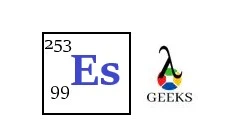Einsteinium properties refer to the physical and chemical facts about the periodic element named Einsteinium. Let us define Einsteinium properties below.
Einsteinium, a transuranic actinide, is one of several elements discovered by a group led by Albert Ghiorso. It was located among the rubble swept away by Ivy Mike’s aftermath.
The facts about Einsteinium would help to know more about the element. The properties of Einsteinium such as melting point, boiling point, atomic weight, electronegativity and others would be discussed throughput this article.
Einsteinium symbol
The symbol of Einsteinium is Es. The most powerfully pronounced two alphabets ‘E’ and ‘S’ from the word ‘Einsteinium’ is used as denoting the element shortly in chemical reactions.
Einsteinium group in periodic table
Einsteinium has no specific group division in the periodic table as it shows various properties as an Actinide element.
Einsteinium period in periodic table
Einsteinium element can be found in period 7 of the periodic table.
Einsteinium block in periodic table
Einsteinium is placed at f block in the periodic table in the horizontal series of other Actinide elements.
Einsteinium atomic number
The atomic number of Einsteinium is 99 that mean it has total 99 protons at the centre and 99 electrons around the nucleus.

Einsteinium atomic Weight
The atomic weight of Einsteinium is 252 u where atomic weight is a relative term of atomic mass in chemistry.
Einsteinium Electronegativity according to Pauling
As per the measurement in Pauling scale, the amount of electronegativity of Einsteinium is 1.3.
Einsteinium atomic Density
The atomic density of Einsteinium is 8.84 g/cm3.
Einsteinium melting point
The melting point of Einsteinium is 860 °C (1133 K, 1580 °F) at which the element starts changing its state from solid to liquid.
Einsteinium boiling point
The boiling point of Einsteinium has been estimated as 996 °C (1269 K, 1825 °F) at which Einsteinium starts evaporating from liquid to gas.
Einsteinium Van der Waals radius
The Van der Waal’s radius of the element, Einsteinium still cannot be obtained exactly due to its gigantic size.
Einsteinium ionic/covalent radius
Covalent radius of Einsteinium is 140 pm which refers to the distance between two einsteinium atom when the make bond through electron sharing.
Einsteinium isotopes
Isotopes are the forms of an atom that differ by the total number of nucleons present in the centre. Let us identify the isotopes of Einsteinium.
Einsteinium has four isotopes 252Es, 253Es, 254Es, and 255Es. 255Es isotope has the shortest half-life in the series and the most stable one is 252Es isotope, which have more than 1 year of half-life.
Einsteinium electronic shell
Electronic shell refers to the space within atoms where the electrons are arranged in a specific manner. Let us identify the arrangement in electrons in shell of Einsteinium.
Einsteinium has 7 electronic shells where the number of electrons is arranged as 2, 8, 18, 32, 29, 8, and 2.
Einsteinium energy of first ionisation
The first ionisation energy of Einsteinium has been calculated as 619 kJ/mol.
Einsteinium energy of second ionisation
Second ionisation energy of Einsteinium is still undefined.
Einsteinium energy of third ionisation
Third ionisation energy level of Einsteinium is also undefined until today.
Einsteinium oxidation states
The oxidation states of Einsteinium are +2, +3, and +4. It means that an atom of this element can remove four electrons at the highest.
Einsteinium electron configurations
Electronic configuration is just the arrangement of electrons in various orbital in accordance with aufbau principle. Let us discuss about the electronic configuration of Es.
Electronic configuration of Einsteinium is [Rn] 5f11 7s2 where the element is focused on the ideal electronic state of Redon in the same period.
Einsteinium CAS number
The CAS registration Id of Einsteinium element is 7429-92-7 for accessing information about the element in Chemical Abstract Service.
Einsteinium ChemSpider ID
The ChemSpider database has given 22356 Id number to Einsteinium to access data about the element online.
Einsteinium allotropic forms
Allotropic forms of an atom are different by physical appearance and structural format. Let us identify the allotropic form if Einsteinium has any allotropes or not.
There is no existence of any allotropic form of Einsteinium element as it is highly reactive and appears with an ideal structure with short half-life.
Einsteinium chemical classification
- Einsteinium can be found as a soft, shiny and silvery metal
- Es is radioactive by nature.
- Es is chemically classified by its typical attitude as a late actinide element.
- Es is a newly discovered element in the periodic table.
Einsteinium state at room temperature
Einsteinium is noticed as a solid metal at room temperature.
Is Einsteinium paramagnetic?
Paramagnetic elements are noticed to have unpaired electrons and capable to exist in magnetic field by creating an attachment. Let us find if Es is paramagnetic or not.
Einsteinium has been found as a paramagnetic element. The element possess unpaired electron in f block.
Conclusion
Einsteinium has been discovered very recently. This element is placed in actinide group as per its typical actinide behaviour. There are several chemical facts are still unknown about the element on which the chemists and scientists are working. This radioactive element would be disclosed more in future.
Read more about Samarium Properties, Terbium Uses, Indium Uses, Iron Uses, Nickel Uses, Thallium Uses, Tellurium Uses, Helium Uses, Hafnium Uses and Potassium Uses

Hi…..I am Sarnali Mukherjee, a graduate from the University of Calcutta. I love to teach and share knowledge on chemistry. I have gradually gained interest in article writing since one year ago. I would love to acquire more knowledge on my subject in the future.
Let’s connect through LinkedIn: